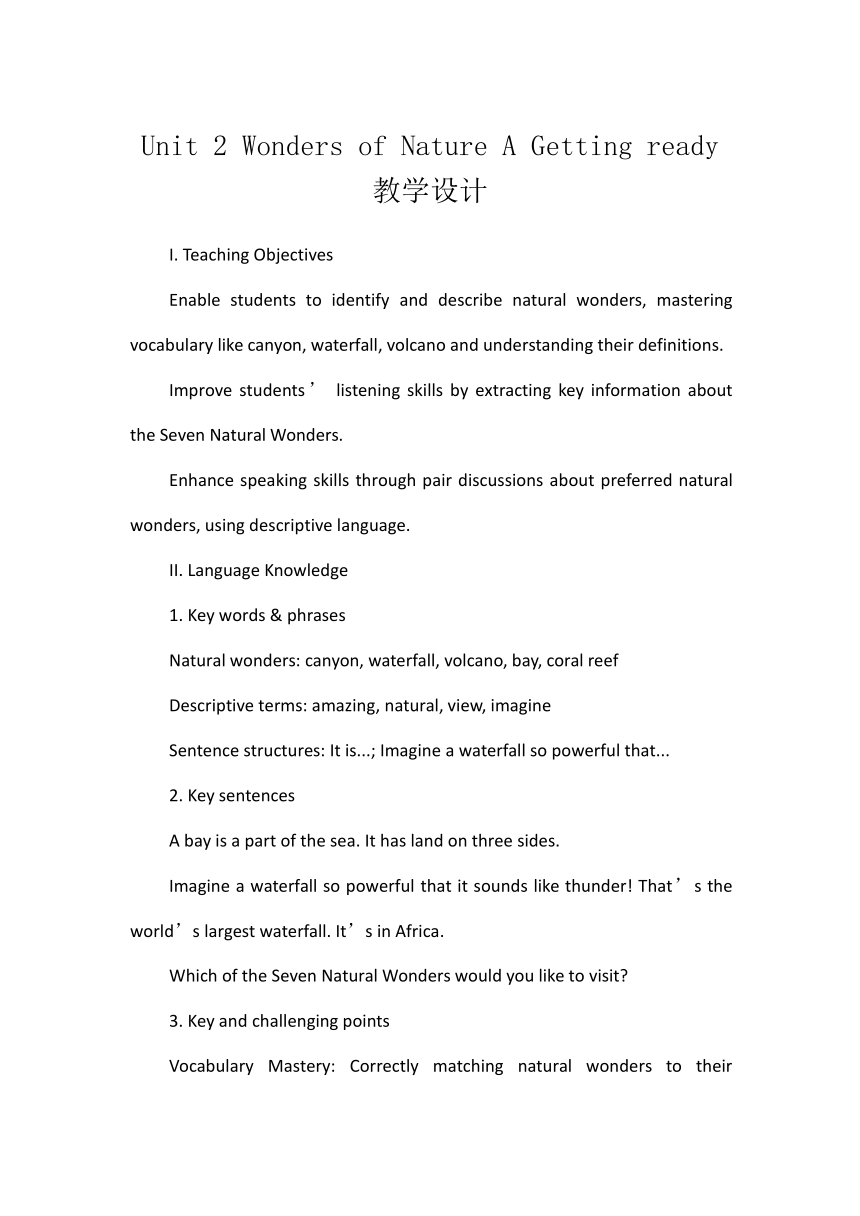
Unit 2 Wonders of Nature A Getting ready教学设计 I. Teaching Objectives Enable students to identify and describe natural wonders, mastering vocabulary like canyon, waterfall, volcano and understanding their definitions. Improve students’ listening skills by extracting key information about the Seven Natural Wonders. Enhance speaking skills through pair discussions about preferred natural wonders, using descriptive language. II. Language Knowledge 1. Key words & phrases Natural wonders: canyon, waterfall, volcano, bay, coral reef Descriptive terms: amazing, natural, view, imagine Sentence structures: It is...; Imagine a waterfall so powerful that... 2. Key sentences A bay is a part of the sea. It has land on three sides. Imagine a waterfall so powerful that it sounds like thunder! That’s the world’s largest waterfall. It’s in Africa. Which of the Seven Natural Wonders would you like to visit 3. Key and challenging points Vocabulary Mastery: Correctly matching natural wonders to their definitions and pictures. Listening Comprehension: Understanding and verifying facts about the Seven Natural Wonders. Oral Expression: Describing preferences for natural wonders with clear reasons. III. Teaching Procedures Step 1: Introduction to Natural Wonders (5 minutes) Show pictures of famous natural wonders (e.g., Grand Canyon, Niagara Falls) and ask: “What do you know about these places What makes them special ” Introduce the lesson: “Today, we’ll learn about the Seven Natural Wonders of the World—their names, features, and why they’re amazing!” Step 2: Vocabulary & Matching (12 minutes) A1: Define & Match Present definitions of bay, canyon, waterfall, volcano (e.g., “A canyon is a narrow, deep space cut by a river through rocks.”). Have students match pictures (a - g) to the Seven Natural Wonders (e.g., 1 Paricutin Volcano matches the volcano image). Discuss answers: Explain why each picture fits (e.g., “The Grand Canyon is a deep, narrow space cut by a river—so it matches the canyon definition.”). Step 3: Listening Practice (10 minutes) A2: Listen & Verify Play the audio introduction to the Seven Natural Wonders. Ask students to listen for: Is there a “widely accepted list” What is the list’s purpose How can people enjoy the wonders Have students mark T/F and discuss answers: 1 T (There is a widely accepted list). 2 T (To encourage discovering nature’s beauty). 3 F (Not the “only way”—people can also learn via media, books, etc.). Step 4: Speaking & Discussion (15 minutes) A3: Complete the Conversation Guide students to fill in blanks with amazing, natural, view (e.g., “natural wonders are so amazing”; “another natural bay”; “powerful natural force”; “wonderful views”). A4: Pair Discussion Have students work in pairs to discuss: “Which natural wonder would you visit Why ” Provide sentence frames: “I want to visit... because...; It looks...; I’d love to see...” Share examples (e.g., “I’d visit the Northern Lights to see th ... ...
~~ 您好,已阅读到文档的结尾了 ~~

